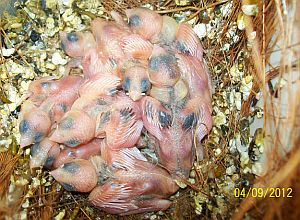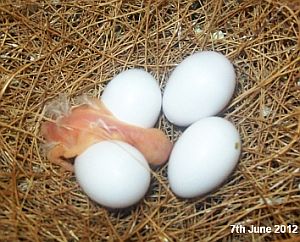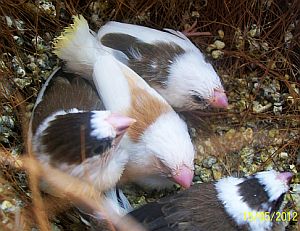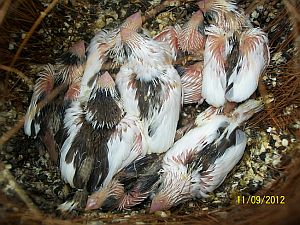
Over the years that I have kept Bengalese I
have talked to and been asked questions by a huge number of novice
bird-keepers new to the Bengalese Finch, 99% of them after they have
bought and began to breed with their birds, although the willingness of
the majority of Bengalese to attempt to reproduce under many
circumstances is not in question it's a bit more than just putting a
pair into a cage with a box and sitting back. I get many questions asked
by mainly hobbiest fanciers, mostly starting " I did what "they" said
without much success. Who can tell how many years of domestication the
Bengalese has had, but even so they are still essentially governed by
the seasons, we can change the environment for our birds so that winter
can be like spring and summer, but to really be successful our birds
need to have the seasonal periods, winter when they rest and tick over,
spring when they gain condition and fitness for breeding, late spring
into summer when they breed, autumn to rest and prepare for winter, a
cycle that ensure not only successful breeding but a life for our
charges that follows nature as closely as it can. we can breed from our
birds at any time of year and I have had youngsters in the nest ready
for the rings to be issued in the first days of the year when Exhibition
was my main occupation,But I always made sure the seasonal periods
applied, my birds were resting at the right stage of the cycle, etc it
was just not dictated by the calender, when I could mimic whatever
condition I wanted by lighting and heating. So try to adhere to the
cycle the birds outside are following, for me Bengalese are as good as
the rarer species and deserve the same as any other species we keep for
pleasure
So my advice and the information you really
started reading this for is.
Assuming your breeding pair are in the best
possible condition for the task ahead, and you encounter no problems
along the way, you can expect the following timetable of events.
Your breeding cage should be ready and
furnished as described in the setting up page.
On introduction to the cage a really fit pair
usually mate almost immediately, but do not worry if this is not the
case as it will not be long before they are bouncing around displaying
to each other and mating takes place.
I have found that pieces of nest material are
important in this courtship display so ensure some is available when you
introduce your birds.
Soon they will discover the nest box, and
commence to carry materials inside as a start to nest building, it is
advisable to start the nest building process by placing a good handful
of materials into the box.
I use soft meadow hay, as sold for rabbits,
placed into the box and then provide coconut fibres for the birds to
line and complete the nest with.
Some pair can frustrate you by ignoring the
box for a while but I have never had a pair that didn’t get the idea in
the end.
Depending on the age and experience of your
birds, the first egg should appear any time after 5 days, although the
average time for this is 8 days.
You can predict the hatching date by counting
18 days from that first precious egg, incubation is only 14 days but
your birds wont start incubating until they have 3 or 4 eggs.
Holding eggs up to the light has never made
any fertile, so never handle your eggs unless it is essential. I am
certain this practise can lead to problems that kill the developing
embryo.
After about a week the semi transparent look
of the eggs will change and they become dull and slightly chalky
looking, this is generally a good sign of fertility, but with experience
you will soon recognise a fertile egg.
A clutch of eggs will not all hatch together,
you should find 2 or 3 youngsters the first day followed by one a day
until hatching is complete. Don’t be in to much of a hurry to remove
unhatched eggs, I have had the odd one hatch 2 or 3 days after the rest,
and they make a good hot water bottle if young chicks are not brooded
for a while.
By the time your babies are 12 days old you
will be able to determine what colour they are, as pin feathers begin to
open out. This is around the time you should be looking to fit your NBFA
closed rings, although this is only a rough guide as some colours need
ringing before others, if in doubt fit the ring, it wont be far away if
it comes off and you can try again later.
Just a word of caution here baby bengies don’t
bounce! So make sure when fitting your rings if you do drop one it
hasn’t far to fall.
At around 25 days they will be found out of
the cage playing around with the seed and water, beginning the process
of feeding themselves.
When they are between 35 and 40 days old they
will usually be independent and feeding themselves.
I find when mine have a fully grown tail they
should be away, another pointer is the commencement of round two by the
parents.
This is the time to take them away and cage
them together. I always try to ensure I place an already weaned
youngster in the same cage to show them the ropes, another thing I
always place the seed and water containers in the same place they were
in the breeding cage.
With your first babies weaned and feeding
themselves they soon begin to fill out, some even revealing their sex,
with young cocks starting to warble softly to themselves.
After 2 or 3 weeks of admiring the fruits of
your labour these swans proceed to turn into ugly duckling, it’s the
start of their first moult.
If all goes smoothly at the age of 3 months
they are revealed in all their glory, fully moulted and hopefully sexed.
The one thing I would advise is patience, the
lack of it contributed to all the mistakes I made causing me to lose
eggs and youngsters
TOP OF THIS PAGE




